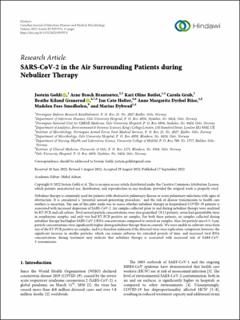| dc.contributor.author | Gohli, Jostein | |
| dc.contributor.author | Brantsæter, Arne Broch | |
| dc.contributor.author | Bøifot, Kari Oline | |
| dc.contributor.author | Grub, Carola | |
| dc.contributor.author | Granerud, Beathe Kiland | |
| dc.contributor.author | Holter, Jan Cato | |
| dc.contributor.author | Dyrhol Riise, Anne Margarita | |
| dc.contributor.author | Smedholen, Madelen Foss | |
| dc.contributor.author | Dybwad, Marius | |
| dc.date.accessioned | 2023-01-23T14:57:58Z | |
| dc.date.available | 2023-01-23T14:57:58Z | |
| dc.date.created | 2022-11-16T14:42:59Z | |
| dc.date.issued | 2022 | |
| dc.identifier.citation | Canadian Journal of Infectious Diseases and Medical Microbiology. 2022, Artikkel 9297974. | en_US |
| dc.identifier.issn | 1712-9532 | |
| dc.identifier.uri | https://hdl.handle.net/11250/3045445 | |
| dc.description.abstract | Nebulizer therapy is commonly used for patients with obstructive pulmonary disease or acute pulmonary infections with signs of obstruction. It is considered a “potential aerosol-generating procedure,” and the risk of disease transmission to health care workers is uncertain. The aim of this pilot study was to assess whether nebulizer therapy in hospitalized COVID-19 patients is associated with increased dispersion of SARS-CoV-2. Air samples collected prior to and during nebulizer therapy were analyzed by RT-PCR and cell culture. Total aerosol particle concentrations were also quantified. Of 13 patients, seven had quantifiable virus in oropharynx samples, and only two had RT-PCR positive air samples. For both these patients, air samples collected during nebulizer therapy had higher SARS-CoV-2 RNA concentrations compared to control air samples. Also, for particle sizes 0.3–5 µm, particle concentrations were significantly higher during nebulizer therapy than in controls. We were unable to cultivate virus from any of the RT-PCR positive air samples, and it is therefore unknown if the detected virus were replication-competent; however, the significant increase in smaller particles, which can remain airborne for extended periods of time, and increased viral RNA concentrations during treatment may indicate that nebulizer therapy is associated with increased risk of SARS-CoV-2 transmission. | en_US |
| dc.language.iso | eng | en_US |
| dc.publisher | Hindawi | en_US |
| dc.rights | Navngivelse 4.0 Internasjonal | * |
| dc.rights.uri | http://creativecommons.org/licenses/by/4.0/deed.no | * |
| dc.title | SARS-CoV-2 in the Air Surrounding Patients during Nebulizer Therapy | en_US |
| dc.type | Peer reviewed | en_US |
| dc.type | Journal article | en_US |
| dc.description.version | publishedVersion | en_US |
| dc.rights.holder | © 2022 Jostein Gohli et al. | en_US |
| dc.subject.nsi | VDP::Medisinske Fag: 700::Klinisk medisinske fag: 750::Infeksjonsmedisin: 776 | en_US |
| dc.subject.nsi | VDP::Medisinske Fag: 700::Klinisk medisinske fag: 750::Lungesykdommer: 777 | en_US |
| dc.source.volume | 2022 | en_US |
| dc.source.journal | Canadian Journal of Infectious Diseases and Medical Microbiology | en_US |
| dc.identifier.doi | 10.1155/2022/9297974 | |
| dc.identifier.cristin | 2075011 | |
| dc.source.articlenumber | 9297974 | en_US |
| cristin.ispublished | true | |
| cristin.fulltext | original | |
| cristin.qualitycode | 1 | |

